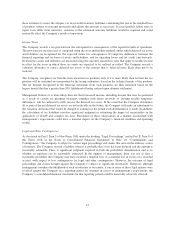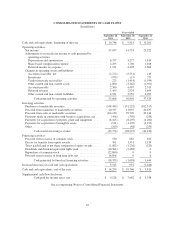Apple 2013 Annual Report Download - page 44
Download and view the complete annual report
Please find page 44 of the 2013 Apple annual report below. You can navigate through the pages in the report by either clicking on the pages listed below, or by using the keyword search tool below to find specific information within the annual report.Item 7A. Quantitative and Qualitative Disclosures About Market Risk
Interest Rate and Foreign Currency Risk Management
The Company regularly reviews its foreign exchange forward and option positions and interest rate swaps, both
on a stand-alone basis and in conjunction with its underlying foreign currency and interest rate related exposures.
Given the effective horizons of the Company’s risk management activities and the anticipatory nature of the
exposures, there can be no assurance these positions will offset more than a portion of the financial impact
resulting from movements in either foreign exchange or interest rates. Further, the recognition of the gains and
losses related to these instruments may not coincide with the timing of gains and losses related to the underlying
economic exposures and, therefore, may adversely affect the Company’s financial condition and operating
results.
Interest Rate Risk
Investments
While the Company is exposed to interest rate fluctuations in many of the world’s leading industrialized
countries, the Company’s interest income is most sensitive to fluctuations in U.S. interest rates. Changes in U.S.
interest rates affect the interest earned on the Company’s cash, cash equivalents and marketable securities, the
fair value of those securities, as well as costs associated with hedging.
The Company’s investment policy and strategy are focused on preservation of capital and supporting the
liquidity requirements of the Company. A portion of the Company’s cash is managed by external managers
within the guidelines of the Company’s investment policy and to objective market benchmarks. The Company’s
internal portfolio is benchmarked against external manager performance.
The Company’s exposure to changes in interest rates relates primarily to the Company’s investment portfolio.
The Company typically invests in highly-rated securities, and its investment policy generally limits the amount of
credit exposure to any one issuer. The policy requires investments generally to be investment grade, with the
primary objective of minimizing the potential risk of principal loss.
To provide a meaningful assessment of the interest rate risk associated with the Company’s investment portfolio,
the Company performed a sensitivity analysis to determine the impact a change in interest rates would have on
the value of the investment portfolio assuming a 100 basis point parallel shift in the yield curve. Based on
investment positions as of September 28, 2013, a hypothetical 100 basis point increase in interest rates across all
maturities would result in a $2.7 billion incremental decline in the fair market value of the portfolio. As of
September 29, 2012, a similar 100 basis point increase in the yield curve would have resulted in a $2.1 billion
incremental decline in the fair market value of the portfolio. Such losses would only be realized if the Company
sold the investments prior to maturity.
Long-Term Debt
In the third quarter of 2013, the Company issued $17.0 billion of long-term debt, which included $3.0 billion of
floating-rate notes. To manage the risk of fluctuations in interest rates associated with the floating-rate notes, the
Company entered into interest rate swaps with an aggregate notional amount of $3.0 billion, which, in effect,
fixed the interest rate of the floating-rate notes.
Foreign Currency Risk
In general, the Company is a net receiver of currencies other than the U.S. dollar. Accordingly, changes in
exchange rates, and in particular a strengthening of the U.S. dollar, will negatively affect the Company’s net
sales and gross margins as expressed in U.S. dollars. There is a risk that the Company will have to adjust local
42
























